From milk to members ...

Portmore Golf Club are the winners of the 2010 Golf Environment Award. Here, father and son, Colin and Josh Webber, chart the move from poa pudding greens to successful sustainable methods.
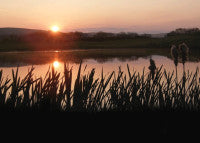 It had been some years since I had taken the long and winding road across country to Barnstable in North Devon and I was expecting my journey to be somewhat tiresome. So, imagine my surprise when I was greeted with the A361 link road from the M5 to the pretty little holiday town.
It had been some years since I had taken the long and winding road across country to Barnstable in North Devon and I was expecting my journey to be somewhat tiresome. So, imagine my surprise when I was greeted with the A361 link road from the M5 to the pretty little holiday town.
The new(ish) road has carved its way through spectacular countryside on the southern edge of Exmoor and, what used to be a journey time of around four hours, has been slashed to just over two.
The reason for my journey was to visit Colin Webber, owner, managing director, course manager and chief cook and bottle washer at Portmore Golf Club, the latest winner of the STRI Golf Environment Awards. "I am gobsmacked" he states. "Imagine my little club winning this award the year after St. Andrews. It's a stunning achievement for all those involved in the club."
The seeds of Portmore Golf Club were planted in 1993 with the building of a twelve bay driving range on land that was owned by Colin. At the time, he was running one of the most intensively managed dairy farms in the UK; "in the top 2% of dairy producers in the country" he says.
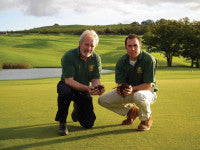 However, the 'Michael Fish' hurricane of October 1987 saw most of the farm buildings flattened. "At one point we were outside trying to hold the roof of the dairy down. We failed. It was a very scary moment."
However, the 'Michael Fish' hurricane of October 1987 saw most of the farm buildings flattened. "At one point we were outside trying to hold the roof of the dairy down. We failed. It was a very scary moment."
Coupled with negative milk quotas, which basically meant that the cost of milk production was more than the sale price, and new European rules on the storage of silage and slurry, Colin took the decision to get out of farming. "I looked at a number of options, including a dry ski run, but eventually decided that golf was the way forward," he says.
By 1994 the driving range had grown to twenty-four bays and, by 1995, Colin was arguing with the local council about public access. Once that was resolved Martin Hawtree was brought in to expand the facilities to include a "proper" 9-hole par 3 course - The Landkey - with the longest hole being 249 yards. This was followed by the front nine of the Barum course in 1999 and the back nine a year later.
Whilst all this was going on, Colin had undertaken a City & Guilds in Golf Greenkeeping and his son, Josh, had also entered the profession, earning a BSc Hons in Sports Turf Science from Myerscough.
Josh has also worked at Loch Lomond Golf Club and participated in the Ohio State University's exchange programme, where he was seconded to work at Boca West Country Club and also Valhalla Golf Club for seventeen months, where, at the latter, he gained a zone leader's position, responsible for holes 5, 6 and 7 during his placement and throughout the 2008 Ryder Cup. Not bad for a twenty-two year old!
 As well as Colin and Josh, the club employ two greenkeepers, Stuart Morgan and Andrew Reay, and Colin's father Frank, who is also a director of the business, tends the semi-rough.
As well as Colin and Josh, the club employ two greenkeepers, Stuart Morgan and Andrew Reay, and Colin's father Frank, who is also a director of the business, tends the semi-rough.
However, the transition from milk to members, on this 180 acre site. has been a long old journey.
"Going from farming to golf was quite a shift in direction," says Josh "Dad had been running a conventional dairy farm where massive inputs were the norm so, when he started his journey he was throwing on the fertiliser and chemicals, as that was what he had always done on the farm. 300kg of nitrogen a year was a common occurrence."
"It was what I was being told to do by everyone in the industry," says Colin, "lecturers, greenkeepers, magazines, the lot."
However, after ending up with "Poa Pudding" greens and lakes full of algae, it was clear that this farming approach had to be rethought.
From the initial design stage, numerous ponds of varying sizes were built to manage water effectively, as this was seen as a priority to combat the effects of climate change. "I'm a believer," says Colin. "You only have to look at our last three summers and winters to see that something is going on with our climate."
"With the predicted hotter summers, heavier rain storms and colder winters it was our aim to collect run-off water from the roads bordering the site," says Josh "and clean it to a point where it was suitable for irrigating the courses whilst, at the same time, reducing the risk of flash flooding. These lakes have been managed in a way that look visually superb and also provide invaluable wildlife habitat. They are now home to kingfishers and otters, which has been great for the members to watch."
 "In addition, over the last five years, we have improved the quality of the environmental roughs by cutting, bailing and removing this bulky material. This has had a number of positive effects, especially as it has made playing golf at Portmore a much more pleasant experience - the ball can now be found and a stroke made at it!"
"In addition, over the last five years, we have improved the quality of the environmental roughs by cutting, bailing and removing this bulky material. This has had a number of positive effects, especially as it has made playing golf at Portmore a much more pleasant experience - the ball can now be found and a stroke made at it!"
"By carrying out these operations we have encouraged the finer grass species and wild flowers which, in turn, has encouraged several species of butterflies - especially the Blues - small mammals and ground nesting birds. Furthermore, hedgerow creation and the erection of bird and owl boxes, along with eco-piles within the woodland areas, has created habitats and food sources that have helped to provide numerous ecological corridors for a vast amount of organisms."
Biological management is an area that is constantly being developed at Portmore. This is a type of turf management that encourages the establishment of beneficial micro-organisms into their playing surfaces. These help to prevent turf plant diseases and pest attacks, whilst previously unavailable water and nutrients become more readily available to the turfgrass plant.
"A teaspoon of healthy living soil has more beneficial organisms than there are people on earth," says Josh. "So, it's no surprise that we are trying to encourage these guys to do all of our work for us, and the best way for us to achieve this is with compost and compost tea applications."
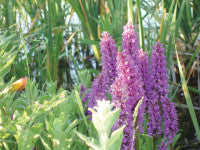 "Compost applications not only provides a wide variety of micro-organisms, but are a source of organic matter in which to feed them and, eventually, the plant. Compost tea is a highly concentrated microbial solution that is produced by "brewing" compost in water in controlled environmental conditions to extract beneficial microbes from the compost. This solution is then applied as either a soil drench or a foliar treatment, to re-inoculate these beneficial microbes back into the soil."
"Compost applications not only provides a wide variety of micro-organisms, but are a source of organic matter in which to feed them and, eventually, the plant. Compost tea is a highly concentrated microbial solution that is produced by "brewing" compost in water in controlled environmental conditions to extract beneficial microbes from the compost. This solution is then applied as either a soil drench or a foliar treatment, to re-inoculate these beneficial microbes back into the soil."
"By utilising beneficial microbiology in our turf systems we hope to, one day, produce totally organic turf surfaces, although we are not as far away from achieving this as you may think, as we haven't used any pesticides, fungicides or insecticides in many years, and currently use very minimal herbicide applications to our main playing areas. In addition, we only use organic fertilisers."
Colin interjects: "In the first year, we were spraying monthly at an annual cost of £30,000. Now, we only spray the fairways for weeds. This year that cost us just over £600!"
"The main reason for moving away from inorganic fertilisers and chemical related applications is that they are highly dependent on fossil fuels and, therefore, are fundamentally unsustainable. Furthermore, there is direct significant scientific evidence that show these types of applications have a detrimental impact on beneficial soil life, which we are trying to encourage in our growing systems."
 "I'm not saying that being organic is the be all and end all of turfgrass management, not by any means. But, if we can produce superb turf, that offers uncompromising quality that basically looks after itself by utilising microbiology, that is produced organically with very little input, I really struggle to see any downfall" says Josh.
"I'm not saying that being organic is the be all and end all of turfgrass management, not by any means. But, if we can produce superb turf, that offers uncompromising quality that basically looks after itself by utilising microbiology, that is produced organically with very little input, I really struggle to see any downfall" says Josh.
One of Portmore's primary goals is to manage the facility in harmony with the environment that surrounds them. Colin and Josh recognise that everything they do has a direct impact on the environment, and analyse every possible option before they make a decision on how to move forward as a club. Over the last five years, they have made significant efforts to promote this mind set, resulting in a number of projects being successfully completed which, in turn, has enhanced the species biodiversity on site and improved the ecological value of the golf courses, allowing a large number of flora and fauna to thrive.
Although it has not been incorporated or analysed in this year's environmental competition, the Portmore team feel they have achieved just as much in the clubhouse as they have on the golf course.
As Colin became more and more involved in sustainable golf club management, he began to wonder about the size of the carbon footprint across the whole site, from the course to the clubhouse and even his own home.
I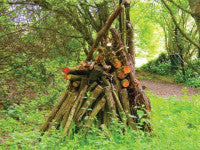 n 2009, he contacted Envision, a South West environmental programme that helped small businesses with their resource efficiency. After an assessment, they told him that the club's annual carbon footprint amounted to 84.98 tonnes. "But, I didn't know if this was good or bad," says Colin. "Then I heard that the British Open Golf tournament alone generated in excess of ten times this amount in just one week. But, I still decided to set a target of getting our footprint down to twenty tonnes in five years."
n 2009, he contacted Envision, a South West environmental programme that helped small businesses with their resource efficiency. After an assessment, they told him that the club's annual carbon footprint amounted to 84.98 tonnes. "But, I didn't know if this was good or bad," says Colin. "Then I heard that the British Open Golf tournament alone generated in excess of ten times this amount in just one week. But, I still decided to set a target of getting our footprint down to twenty tonnes in five years."
Colin's focus was on a number of areas around the club, including rainwater harvesting to wash range balls and flush toilets, providing recycling bins, replacing old light bulbs with low-energy ones, fitting sensors to all rooms and 24-hour timers to any electrical device that didn't need 24-hour use.
Here, the clubhouse deserves a special mention. It has been constructed using seven portacabins, although you would never know it until the cleverly disguised joins were pointed out.
"I uncovered the portacabins whilst on a visit to Lancashire," says Colin. "So, I was straight on the phone to my bank manager to arrange the finance to ensure cranes at both ends and transport back to Devon that same day. As it turned, out the crane company back home also had some portacabins they no longer wanted, so that cut part of the transport costs down."
"We had all the skills we could possibly want within our membership, along with two nuclear scientists that I couldn't quite find a use for, other than manual labour!"
"The members set about 'their' clubhouse with incredible enthusiasm," says Colin. "I was the fetcher and carrier. I'd be up early to complete all the mowing tasks as soon as possible, then I'd be off to the local building suppliers in my old Montego saloon to ferry back whatever was required - cement, plywood, paint, plasterboard, light fittings. You name it, somehow I managed to get it in the Montego!"
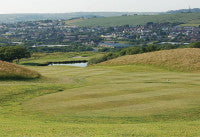 The finished result is a shining example of commitment and quality tradesmanship. "The members did all this work voluntarily," says Colin, "although I did give each and every one free membership the following year. I am eternally grateful to them."
The finished result is a shining example of commitment and quality tradesmanship. "The members did all this work voluntarily," says Colin, "although I did give each and every one free membership the following year. I am eternally grateful to them."
"With the clubhouse completed, we then focused on our water quality to help us become compliant with the new ground water regulations of April 2010," continues Josh. "This involved changing all of our cleaning products in the clubhouse to environmentally friendly replacements; this had an immediate effect by improving the discharge water from the septic tank. We then built our own environmentally friendly wash-pad for cleaning the golf course equipment and containing the water, allowing it to be re-used."
Colin is now setting his sights on renewable energy production. In the months to come, he plans to install a woodburner in the clubhouse that will be able to provide heating throughout the winter. Then he intends to install photovoltaic solar panels to provide energy throughout the year for the clubhouse and the electric mowers and buggies. "Electricity forms 54% of our carbon footprint and here, at last, is a sure-fire way of getting rid of that ever increasing bill," Colin says.
Of course, Colin has not reduced just the club's carbon footprint but its running costs too, which continue to come down. "For example, our annual water bills are down from around £6,000 to under £500, and our power bills have fallen significantly," he says. "You must remember, though, that costs have risen by around 40% in that time, but our bills are reducing every year. When the woodburner and PV panels are introduced they will punch a massive hole in over half of our carbon production."
"For us, this is very much a team effort and we are looking to achieve great things as a club. Therefore, we have to look at every aspect of the club and not just the two golf courses," says Colin.
So, what does the future hold for Portmore? "As a facility, mine and Josh's aim is to become a totally self sufficient facility that provides two Soil Association certificated golf courses that not only offer uncompromising turf quality but also enhance the natural biodiversity of the site, by providing a number of different environments for a multitude of plants and animals to develop."
And does Colin ever regret moving away from large scale farming? "No, not at all. Running this golf course is immensely rewarding, and I would not have had the opportunity to help out at this years Ryder Cup had Celtic Manor's Jim McKenzie not seen my work here. That was a fantastic opportunity for me and one I shall always treasure. The camaraderie and banter during, what were, very difficult conditions was excellent."
"But, we do intend to have a small farm where I can keep a few chickens and animals to produce our own food for the clubhouse," Colin says with a smile. "That will help to make Portmore a truly zero carbon footprint facility."
The STRI's Richard Studdard, this year's judge, commented in his final report. "As an overall package, Portmore Golf Club is second to none in terms of the vast array of ecological and environmental projects that Colin, Josh and the whole team have implemented, whilst still maintaining a golf course that is of an excellent standard that can be enjoyed by all."
Worthy winners of the STRI Golf Environment Award? You'd have to say so.
